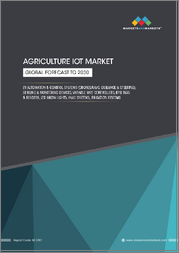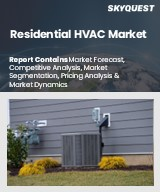
|
시장보고서
상품코드
1616114
통합 공조 시스템 시장 성장 기회, 성장 촉진요인, 산업 동향 분석 및 예측(2024-2032년)Integrated Air Conditioning (RIAC) Systems Market Opportunity, Growth Drivers, Industry Trend Analysis, and Forecast 2024 - 2032 |
||||||
세계 통합 공조(RIAC) 시스템 시장은 2023년 115억 달러 규모로 평가되었고, 2024-2032년간 연평균 4.3% 성장할 것으로 예상됩니다.
스마트 홈 시스템의 부상은 첨단 공조 시스템의 성장을 크게 촉진하여 사용자 제어, 편의성 및 효율성을 향상시키고 있습니다. 스마트 홈 기술의 출현으로 사용자는 스마트폰, 태블릿 또는 음성 어시스턴트를 통해 에어컨 시스템을 쉽게 관리할 수 있게 되어 비교할 수 없는 유연성을 제공합니다. 자동 스케줄링 및 실시간 에너지 모니터링과 같은 기능은 에너지를 절약하고 비용을 절감할 뿐만 아니라 환경에도 도움이 됩니다. 또한 이러한 스마트 시스템은 온도 조절기 및 센서와 같은 장치와 통합되어 거주 상황 및 외부 조건에 적응하는 통합 공조 제어 시스템을 형성할 수 있습니다.
또한 덕트 네트워크를 통해 다양한 방의 균일한 온도 제어를 실현할 수 있기 때문에 건물 전체 공조에 가장 적합합니다. 기술에 따라 통합 공조 시스템 시장은 인버터 기술과 비인버터 기술로 나뉘며, 2023년에는 인버터 기술 부문이 54.61%의 압도적인 점유율로 시장을 주도하고 있습니다. 예측에 따르면, 이 부문은 2032년까지 93억 1,000만 달러의 가치를 목표로 우위를 유지할 것으로 예상됩니다. 인버터 기술은 뛰어난 효율성, 성능 및 사용자 중심의 장점으로 인해 공조 부문에서 두각을 나타내고 있습니다.
| 시장 범위 | |
|---|---|
| 시작 연도 | 2023년 |
| 예측 연도 | 2024-2032년 |
| 시작 가격 | 115억 달러 |
| 예상 가격 | 166억 6,000만 달러 |
| CAGR | 4.3% |
고정 속도 압축기(완전 가동 또는 완전 정지)로 작동하는 기존 시스템과 달리 인버터 기술은 난방 또는 냉방 수요에 따라 실시간으로 압축기 속도를 조절하여 2023년 아시아태평양이 통합 공조 시스템 시장을 장악하여 32.99의 점유율을 차지할 것으로 예상됩니다. 이 지역은 인구가 밀집되어 있고 도시 지역이 확장되고 있어 주거 및 상업 부문 모두에서 효율적인 공조 제어에 대한 수요가 큽니다. 인도와 중국과 같은 열대 및 아열대 기후 국가에서는 에어컨에 대한 수요가 증가하고 있습니다. 경제 성장과 가처분 소득 증가로 인해 가정과 사무실의 편안함에 대한 투자가 증가하고 있습니다. 경제 성장과 가처분 소득 증가로 가정과 사무실의 편안함에 대한 투자가 증가하고 있습니다. 중산층의 확대는 이러한 수요를 더욱 촉진하고 있습니다.
목차
제1장 조사 방법과 조사 범위
제2장 주요 요약
제3장 산업 인사이트
- 생태계 분석
- 밸류체인에 영향을 미치는 요인
- 이익률 분석
- 변혁
- 향후 전망
- 제조업체
- 유통업체
- 규제 상황
- 영향요인
- 성장 촉진요인
- 산업의 잠재적 리스크와 과제
- 소비자 구매 행동 분석
- 인구 동향
- 구매 결정에 영향을 미치는 요인
- 소비자 제품 채택
- 선호 유통 채널
- 희망 가격대
- 성장 가능성 분석
- Porter's Five Forces 분석
- PESTEL 분석
제4장 경쟁 구도
- 서론
- 기업 점유율 분석
- 경쟁 포지셔닝 매트릭스
- 전략 전망 매트릭스
제5장 시장 추정·예측 : 제품별, 2021-2032년
- 주요 동향
- 센트럴 공조 시스템
- 덕트리스 스플릿 시스템
- 하이브리드 시스템
- 포장 공조 시스템
- Vrf(냉매 유량 가변) 시스템
제6장 시장 추정·예측 : 기술별, 2021-2032년
- 주요 동향
- 인버터 기술
- 논인버터 기술
제7장 시장 추정·예측 : 에너지원별, 2021-2032년
- 주요 동향
- 전기
- 가스
- 하이브리드 시스템
제8장 시장 추정·예측 : 용도별, 2021-2032년
- 주요 동향
- 주택용
- 상업용
- 산업용
- 기타(운송 등)
제9장 시장 추정·예측 : 분산 시스템별, 2021-2032년
- 주요 동향
- 덕트
- 덕트리스 시스템
제10장 시장 추정·예측 : 지역별, 2021-2032년
- 주요 동향
- 북미
- 미국
- 캐나다
- 유럽
- 독일
- 영국
- 프랑스
- 이탈리아
- 스페인
- 기타 유럽
- 아시아태평양
- 중국
- 인도
- 일본
- 한국
- 호주
- 기타 아시아태평양
- 라틴아메리카
- 브라질
- 멕시코
- 기타 라틴아메리카
- 중동 및 아프리카
- 아랍에미리트(UAE)
- 사우디아라비아
- 남아프리카공화국
- 기타 중동 및 아프리카
제11장 기업 개요
- Daikin Industries Ltd.
- Mitsubishi Electric Corporation
- Carrier Global Corporation
- Johnson Controls International plc
- Trane Technologies plc
- LG Electronics Inc.
- Samsung Electronics Co., Ltd.
- Hitachi Ltd.
- Bosch Thermotechnology
- Fujitsu General Limited
- Toshiba Carrier Corporation
- Lenovo Group Limited
- Panasonic Corporation
- Siemens AG
- Rheem Manufacturing Company
The Global Integrated Air Conditioning (RIAC) Systems Market was valued at USD 11.5 billion in 2023 and is projected to grow at a CAGR of 4.3% from 2024 to 2032. The rise of smart home systems is significantly propelling the growth of advanced air conditioning systems, enhancing user control, convenience, and efficiency. With the advent of smart home technology, users can effortlessly manage their air conditioning systems through smartphones, tablets, or voice assistants, providing unparalleled flexibility. Features such as automated scheduling and real-time energy monitoring not only conserve energy and cut costs but also benefit the environment. Furthermore, these smart systems can integrate with devices like thermostats and sensors, forming a cohesive climate control system that adapts to occupancy and external conditions.
The overall integrated air conditioning (RIAC) systems industry is classified based on product type, application, technology, energy source, distribution channel, and region. The market is categorized by product type: Central Air Conditioning Systems, Ductless Split Systems, Hybrid Systems, Packaged Air Conditioning Systems, and VRF (Variable Refrigerant Flow) Systems. In 2023, the Central Air Conditioning Systems segment led the market, securing a notable 37.33% share. This segment is set to dominate the overall market share, with projections estimating a valuation of USD 6.40 Billion by 2032. Central air conditioning systems are favored for their ability to cool entire homes or expansive buildings using a single, centralized unit.
They ensure uniform temperature control across various rooms through a duct network, making them perfect for whole-home applications. Based on technology, the integrated air conditioning systems market is divided into Inverter technology and non-inverter technology. In 2023, the Inverter technology segment led the market with a commanding 54.61% share. Projections indicate this segment will continue its dominance, aiming for a valuation of USD 9.31 Billion by 2032. Inverter technology stands out in the air conditioning landscape due to its superior efficiency, performance, and user-centric benefits.
| Market Scope | |
|---|---|
| Start Year | 2023 |
| Forecast Year | 2024-2032 |
| Start Value | $11.5 Billion |
| Forecast Value | $16.66 Billion |
| CAGR | 4.3% |
Unlike traditional systems that operate on fixed-speed compressors (either running at full capacity or shutting off entirely), inverter technology modulates the compressor speed in real-time to meet heating or cooling demands. In 2023, the Asia-Pacific (APAC) region dominated the Integrated Air Conditioning Systems Market, holding a 32.99% share. The region's dense population and expanding urban areas drive a significant demand for efficient climate control in both residential and commercial sectors. Countries like India and China, with their tropical and subtropical climates, have an amplified need for air conditioning.Economic growth and increasing disposable incomes have led to heightened investments in home and office comfort. The expanding middle class further fuels this demand.
Table of Contents
Chapter 1 Methodology & Scope
- 1.1 Market scope & definition
- 1.2 Base estimates & calculations
- 1.3 Forecast parameters
- 1.4 Data sources
- 1.4.1 Primary
- 1.4.2 Secondary
- 1.4.2.1 Paid sources
- 1.4.2.2 Public sources
Chapter 2 Executive Summary
- 2.1 Industry 360° synopsis, 2021 - 2032
Chapter 3 Industry Insights
- 3.1 Industry ecosystem analysis
- 3.1.1 Factor affecting the value chain
- 3.1.2 Profit margin analysis
- 3.1.3 Disruptions
- 3.1.4 Future outlook
- 3.1.5 Manufacturers
- 3.1.6 Distributors
- 3.2 Regulatory landscape
- 3.3 Impact forces
- 3.3.1 Growth drivers
- 3.3.1.1 Integration of smart home systems
- 3.3.1.2 Growing awareness and concern about environmental impact
- 3.3.1.3 Urbanization and space constraints
- 3.3.2 Industry pitfalls & challenges
- 3.3.2.1 Higher upfront Investment
- 3.3.1 Growth drivers
- 3.4 Consumer buying behavior analysis
- 3.4.1 Demographic trends
- 3.4.2 Factors affecting buying decision
- 3.4.3 Consumer product adoption
- 3.4.4 Preferred distribution channel
- 3.4.5 Preferred price range
- 3.5 Growth potential analysis
- 3.6 Porter's analysis
- 3.7 PESTEL analysis
Chapter 4 Competitive Landscape, 2023
- 4.1 Introduction
- 4.2 Company market share analysis
- 4.3 Competitive positioning matrix
- 4.4 Strategic outlook matrix
Chapter 5 Market Estimates & Forecast, By Product, 2021 - 2032, (USD Billion) (Thousand Units)
- 5.1 Key trends
- 5.2 Central air conditioning systems
- 5.3 Ductless split systems
- 5.4 Hybrid systems
- 5.5 Packaged air conditioning systems
- 5.6 Vrf (variable refrigerant flow) systems
Chapter 6 Market Estimates & Forecast, By Technology, 2021 - 2032, (USD Billion) (Thousand Units)
- 6.1 Key trends
- 6.2 Inverter technology
- 6.3 Non-Inverter technology
Chapter 7 Market Estimates & Forecast, By Energy Source, 2021 - 2032, (USD Billion) (Thousand Units)
- 7.1 Key trends
- 7.2 Electric
- 7.3 Gas
- 7.4 Hybrid systems
Chapter 8 Market Estimates & Forecast, By Application, 2021 - 2032, (USD Billion) (Thousand Units)
- 8.1 Key trends
- 8.2 Residential
- 8.3 Commercial
- 8.4 Industrial
- 8.5 Others (transportation etc)
Chapter 9 Market Estimates & Forecast, By Distribution System, 2021 - 2032, (USD Billion) (Thousand Units)
- 9.1 Key trends
- 9.2 Ducted systems
- 9.3 Ductless systems
Chapter 10 Market Estimates & Forecast, By Region, 2021 - 2032, (USD Billion) (Thousand Units)
- 10.1 Key trends
- 10.2 North America
- 10.2.1 U.S.
- 10.2.2 Canada
- 10.3 Europe
- 10.3.1 Germany
- 10.3.2 UK
- 10.3.3 France
- 10.3.4 Italy
- 10.3.5 Spain
- 10.3.6 Rest of Europe
- 10.4 Asia Pacific
- 10.4.1 China
- 10.4.2 India
- 10.4.3 Japan
- 10.4.4 South Korea
- 10.4.5 Australia
- 10.4.6 Rest of Asia Pacific
- 10.5 Latin America
- 10.5.1 Brazil
- 10.5.2 Mexico
- 10.5.3 Rest of Latin America
- 10.6 MEA
- 10.6.1 UAE
- 10.6.2 Saudi Arabia
- 10.6.3 South Africa
- 10.6.4 Rest of MEA
Chapter 11 Company Profiles (Business Overview, Financial Data, Product Landscape, Strategic Outlook, SWOT Analysis)
- 11.1 Daikin Industries Ltd.
- 11.2 Mitsubishi Electric Corporation
- 11.3 Carrier Global Corporation
- 11.4 Johnson Controls International plc
- 11.5 Trane Technologies plc
- 11.6 LG Electronics Inc.
- 11.7 Samsung Electronics Co., Ltd.
- 11.8 Hitachi Ltd.
- 11.9 Bosch Thermotechnology
- 11.10 Fujitsu General Limited
- 11.11 Toshiba Carrier Corporation
- 11.12 Lenovo Group Limited
- 11.13 Panasonic Corporation
- 11.14 Siemens AG
- 11.15 Rheem Manufacturing Company



















